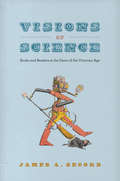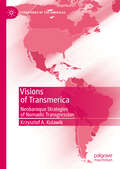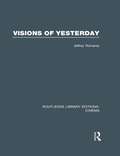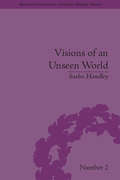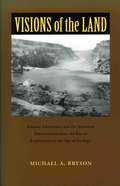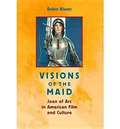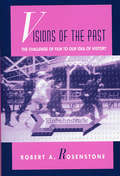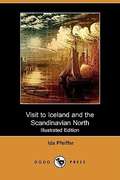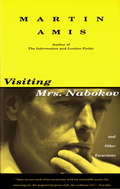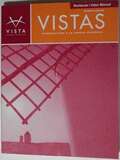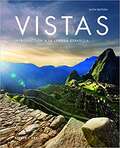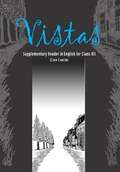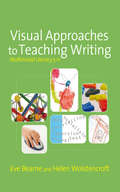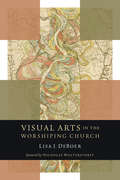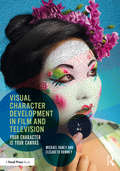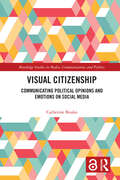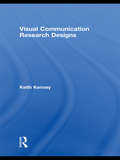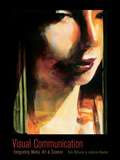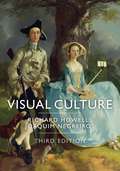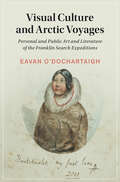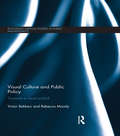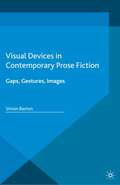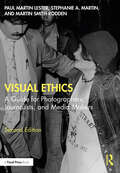- Table View
- List View
Visions of Science: Books and Readers at the Dawn of the Victorian Age
by James A. SecordThe first half of the nineteenth century witnessed an extraordinary transformation in British political, literary, and intellectual life. There was widespread social unrest, and debates raged regarding education, the lives of the working class, and the new industrial, machine-governed world. At the same time, modern science emerged in Europe in more or less its current form, as new disciplines and revolutionary concepts, including evolution and the vastness of geologic time, began to take shape. In Visions of Science, James A. Secord offers a new way to capture this unique moment of change. He explores seven key books—among them Charles Babbage’s Reflections on the Decline of Science, Charles Lyell’s Principles ofGeology, Mary Somerville’s Connexion of the Physical Sciences, and Thomas Carlyle’s Sartor Resartus—and shows how literature that reflects on the wider meaning of science can be revelatory when granted the kind of close reading usually reserved for fiction and poetry. These books considered the meanings of science and its place in modern life, looking to the future, coordinating and connecting the sciences, and forging knowledge that would be appropriate for the new age. Their aim was often philosophical, but Secord shows it was just as often imaginative, projective, and practical: to suggest not only how to think about the natural world but also to indicate modes of action and potential consequences in an era of unparalleled change. Visions of Science opens our eyes to how genteel ladies, working men, and the literary elite responded to these remarkable works. It reveals the importance of understanding the physical qualities of books and the key role of printers and publishers, from factories pouring out cheap compendia to fashionable publishing houses in London’s West End. Secord’s vivid account takes us to the heart of an information revolution that was to have profound consequences for the making of the modern world.
Visions of Transmerica: Neobaroque Strategies of Nomadic Transgression (Literatures of the Americas)
by Krzysztof A. KulawikThis book looks at Neobaroque Latin American fiction, poetry, essay and performance from the 1970s to the early 2000s in order to explore the cultural hybridization and transgressive identity transformations at play in these works. It shows how the ornamental style and boldly experimental techniques are an effective strategy in presenting decentered identities in sexually ambiguous, multiethnic, interracial, transcultural, and mutant characters, as well as in metafictional narrators and authors. In this way, the book demonstrates the potential of Neobaroque works to destabilize normative, essentialist and binary categories of identity. The study focuses on Latin America as a cultural macroregion, drawing on examples from a variety of countries, including Argentina, Uruguay, Chile, Bolivia, Brazil, Cuba, Mexico, and the US-Mexican border. Drawing on gender, queer, trans and Chicana feminist theory, it argues for an alternative approach to a model of the Self, or a theory of selfhood, derived from the exuberant style and experimental techniques of the Neobaroque.
Visions of Yesterday (Routledge Library Editions: Cinema)
by Jeffrey RichardsFilm is an important source of social history, as well as having been a popular art form from the early twentieth century. This study shows how a society, consciously or unconsciously, is mirrored in its cinema. It considers the role of the cinema in dramatizing popular beliefs and myths, and takes three case studies – American populism, British imperialism, German Nazism – to explain how a nation’s pressures, tensions and hopes come through in its films. Examining the American cinema is accomplished by analysing the careers of three great directors, John Ford, Frank Capra and Leo McCarey, while the British and German cinemas are studied by theme. The analysis of the British Empire as seen in film broke exciting new ground with a pioneering account of ‘the cinema of Empire’ when it was first published in 1973. With full filmographies and a carefully selected bibliography it is an outstanding work of reference and its lively approach makes it a delight to read. Reviews of the original edition: ‘A work of considerable force and considerable wit.’ – Clive James, Observer ‘…a work that is original, mentally stimulating and most pleasurable to read.’ – Focus on Film
Visions of an Unseen World: Ghost Beliefs and Ghost Stories in Eighteenth Century England (Religious Cultures in the Early Modern World #2)
by Sasha HandleyA study of the production, circulation and consumption of English ghost stories during the Age of Reason. This work examines a variety of mediums: ballads and chapbooks, newspapers, sermons, medical treatises and scientific journals, novels and plays. It relates the telling of ghost stories to changes associated with the Enlightenment.
Visions of the Land: Science, Literature, and the American Environment from the Era of Exploration to the Age of Ecology (Under the Sign of Nature: Explorations in Ecocriticism)
by Michael A. BrysonThe work of John Charles Fremont, Richard Byrd, Charlotte Perkins Gilman, John Wesley Powell, Susan Cooper, Rachel Carson, and Loren Eiseley represents a widely divergent body of writing. Yet despite their range of genres--including exploration narratives, technical reports, natural histories, scientific autobiographies, fictional utopias, nature writing, and popular scientific literature--these seven authors produced strikingly connected representations of nature and the practice of science in America from about 1840 to 1970. Michael A. Bryson provides a thoughtful examination of the authors, their work, and the ways in which science and nature unite them.Visions of the Land explores how our environmental attitudes have influenced and been shaped by various scientific perspectives from the time of western expansion and geographic exploration in the mid-nineteenth century to the start of the contemporary environmental movement in the twentieth century. Bryson offers a literary-critical analysis of how writers of different backgrounds, scientific training, and geographic experiences represented nature through various kinds of natural science, from natural history to cartography to resource management to ecology and evolution, and in the process, explored the possibilities and limits of science itself.Visions of the Land examines the varied, sometimes conflicting, but always fascinating ways in which we have defined the relations among science, nature, language, and the human community. Ultimately, it is an extended meditation on the capacity of using science to live well within nature.
Visions of the Maid
by Robin BlaetzRepresentations of Joan of Arc have been used in the United States for the past two hundred years, appearing in advertising, cartoons, popular song, art, criticism, and propaganda. The presence of the fifteenth-century French heroine in the cinema is particularly intriguing in relation to the role of women during wartime. Robin Blaetz argues that a mythic Joan of Arc was used during the First World War to cast a medieval glow over an unpopular war, but that she only appeared after the Second World War to encourage women to abandon their wartime jobs and return to the home.In Visions of the Maid, Blaetz examines three pivotal films -- Cecil B. DeMille's 1916 Joan the Woman, Victor Fleming's 1948 Joan of Arc, and Otto Preminger's 1957 Saint Joan -- as well as addressing a broad array of popular culture references and every other film about the heroine made or distributed in the United States. Blaetz is particularly concerned with issues of gender and the ways in which Joan of Arc's androgyny, virginity, and sacrificial victimhood were evoked in relation to the evolving roles of women during war throughout the twentieth century.
Visions of the Past: The Challenge of Film to Our Idea of History
by Robert A. RosenstoneCan filmed history measure up to written history? What happens to history when it is recorded in images, rather than words? Can images convey ideas and information that lie beyond words? Taking on these timely questions, Robert Rosenstone pioneers a new direction in the relationship between history and film. Rosenstone moves beyond traditional approaches, which examine the history of film as art and industry, or view films as texts reflecting their specific cultural contexts. This essay collection makes a radical venture into the investigation of a new concern: how a visual medium, subject to the conventions of drama and fiction, might be used as a serious vehicle for thinking about our relationship with the past. Rosenstone looks at history films in a way that forces us to reconceptualize what we mean by "history." He explores the innovative strategies of films made in Africa, Latin America, Germany, and other parts of the world. He journeys into the history of film in a wide range of cultures, and expertly traces the contours of the postmodern historical film. In essays on specific films, including Reds, JFK, and Sans Soleil, he considers such issues as the relationship between fact and film and the documentary as visionary truth. Theorists have for some time been calling our attention to the epistemological and literary limitations of traditional history. The first sustained defense of film as a way of thinking historically, this book takes us beyond those limitations.
Visit to Iceland and the Scandinavian North
by Ida PfeifferA besetting sin of the Icelanders is their drunkenness. Their poverty would probably not be so great if they were less devoted to brandy, and worked more industriously. <P> <P> It is dreadful to see what deep root this vice has taken. Not only on Sundays, but also on week-days, I met peasants who were so intoxicated that I was surprised how they could keep in their saddle. I am, however, happy to say that I never saw a woman in this degrading condition.
Visiting Mrs. Nabokov
by Martin AmisTo this tantalizing nonfiction collection Martin Amis brings the same megawatt wit, wickedly acute perception, and ebullient wordplay that characterize his novels. He encompasses the full range of contemporary politics and culture (high and low) while also traveling to China for soccer with Elton John and to London's darts-crazy pubs in search of the perfect throw. Throughout, he offers razor-sharp takes on such subjects as:American politics: "If history is a nightmare from which we are trying to awake, then the Reagan era can be seen as an eight-year blackout. Numb, pale, unhealthily dreamless: eight years of Do Not Disturb."Chess: "Nowhere in sport, perhaps in human activity, is the gap between the tryer and the expert so astronomical.... My chances of a chess brilliancy are the 'chances' of a lab chimp and a type writer producing King Lear."From the Trade Paperback edition.
Vistas Introduccion A La Lengua Espanola
by José A. Blanco Philip Redwine DonleyVistas Introduccion A La Lengua Espanola, Student Edition
Vistas Introduccion a La Lengua Espanola
by Jose A. BlancoWith the interactive grammar and vocabulary practice, engaging media, and communicative tasks in Vistas, introductory students gain confidence and the cultural understanding needed to take them to the next level. Continuing in the tradition of delivering a fresh, student-friendly approach, the 6th Edition makes students’ learning—and instructor’s teaching—easier and more successful.
Vistas in Reading Literature: Silver Level
by Donna NortonA reader on the fifth-grade level with stories, poems, plays, and nonfiction by world-famous authors. Includes study questions, activities, and exercises.
Vistas: Supplementary Reader in English (Core Course) class 12 - NCERT - 23
by National Council Of Educational Research And Training"Vistas" is an English textbook for Class 12 published by NCERT. It contains a collection of diverse short stories written by renowned authors. The book aims to enhance students' reading comprehension, vocabulary, and analytical skills while exposing them to different literary genres. Some notable stories include "The Third Level" by Jack Finney, exploring escapism; "The Tiger King" by Kalki Krishnamurthy, a satirical account of a tiger-obsessed king; "Journey to the End of the Earth" by Tishani Doshi, reflecting on self-discovery; "Memories of Childhood" by Zitkala-Sa, an autobiographical account; and "The Enemy" by Pearl S. Buck, portraying complex dynamics during WWII. These stories encourage critical analysis and provide insights into social, cultural, and human aspects.
Visual Approaches to Teaching Writing: Multimodal Literacy 5 - 11 (Published in association with the UKLA)
by Helen Wolstencroft Ms Eve BearneIncludes CD-Rom Why are visual approaches to literacy important? Children's experience of texts is no longer limited to words on printed pages - their reading and writing worlds are formed in multimodal ways, combining different modes of communication, including speech or sound, still or moving images, writing and gesture. This book is a practical guide for teachers in making sense of multimodal approaches to teaching writing. The book covers topics such as: - The design of multimodal texts and the relationships between texts and images - How to build a supportive classroom environment for analysing visual and audiovisual texts, and how to teach about reading images - How to plan a teaching sequence leading to specific writing outcomes - Examples of teaching sequences for developing work on narrative, non-fiction and poetry - Formative and summative assessment of multimodal texts, providing levels for judging pupil development, and suggestions for moving pupils forward - How to write, review and carry out a whole school policy for teaching multimodal writing The book is accompanied by a CD, which contains a range of examples of children's multimodal work, along with electronic versions of the activities and photocopiable sheets from the book, and material designed for use with interactive whiteboards. It will be a valuable resource for primary teachers, literacy co-ordinators and students on initial teacher training courses. Visit the UKLA's website : here
Visual Arts in the Worshiping Church (Calvin Institute of Christian Worship Liturgical Studies)
by Nicholas Wolterstorff Lisa DeBoerAlthough numerous studies have examined biblical and theological rationales for using the visual arts in worship, this book by Lisa J. DeBoer fills in a piece of the picture missing so far — the social dimensions of both our churches and the various art worlds represented in our congregations. The first part of the book looks at Orthodoxy, Catholicism, and Protestantism in turn — including case studies of specific congregations — showing how each tradition’s use of the visual arts reveals an underlying ecclesiology. DeBoer then focuses on six themes that emerge when Orthodox, Catholic, and Protestant uses of the visual arts are examined together — the arts as expressions of the church’s local and universal character, the meanings attributed to particular styles of art for the church, the role of the arts in enculturating the gospel, and more. DeBoer’s Visual Arts in the Worshiping Church will focus and deepen the thinking of pastors, worship leaders, artists, students, and laypeople regarding what the arts might do in the midst of their congregations.
Visual Arts in the Worshiping Church (Calvin Institute of Christian Worship Liturgical Studies)
by Lisa DeBoerAlthough numerous studies have examined biblical and theological rationales for using the visual arts in worship, this book by Lisa J. DeBoer fills in a piece of the picture missing so far — the social dimensions of both our churches and the various art worlds represented in our congregations. The first part of the book looks at Orthodoxy, Catholicism, and Protestantism in turn — including case studies of specific congregations — showing how each tradition&’s use of the visual arts reveals an underlying ecclesiology. DeBoer then focuses on six themes that emerge when Orthodox, Catholic, and Protestant uses of the visual arts are examined together — the arts as expressions of the church&’s local and universal character, the meanings attributed to particular styles of art for the church, the role of the arts in enculturating the gospel, and more. DeBoer&’s Visual Arts in the Worshiping Church will focus and deepen the thinking of pastors, worship leaders, artists, students, and laypeople regarding what the arts might do in the midst of their congregations.
Visual Character Development in Film and Television: Your Character is Your Canvas
by Michael Hanly Elisabeth RowneyThis book takes a unique look at visual character development in motion pictures and television by using famous works of art combined with modern works of film and television to demonstrate how to weave a visual tale. In a single shot or scene, what should we reveal about a character? What should we conceal? How can we show a character’s progression over time? In Visual Character Development in Film and Television, authors Michael Hanly and Elisabeth Rowney explain how to create compelling visual characters for the screen by analyzing fine art aesthetics and combining them with modern cinematic techniques. Full-color chapters cover character-driven approaches to costume design and makeup application, production design, cinematography and lighting, plot development, editing considerations, and more. By exploring how surroundings, habits, lifestyles – even the color of a sweater – can tell us more about a character on the screen than what can be said in dialogue alone, this book will prove a valuable resource for anyone wanting to take their filmmaking to the next level.
Visual Citizenship: Communicating political opinions and emotions on social media (Routledge Studies in Media, Communication, and Politics)
by Catherine BoukoThis book explores visual political engagement online – how citizens participate in the dynamism of life in society by expressing their opinions and emotions on various issues of democratic life in image-based social media posts, independently of collective actions.Looking beyond large digital social movements to focus on the everyday, the book provides a well-documented and comprehensive framework of key notions, concrete methods and examples of empirical insights into everyday visual citizenship on social media. It shows how the visual has become ubiquitous in citizens’ communication on social media, focusing on how citizens use visual content to express their emotions and opinions on social media platforms when they discuss politics in a large sense.With this book, every reader interested in political communication, visual communication and/or new media is fully equipped to analyse everyday visual citizenship on social media platforms.The Open Access version of this book, available at http://www.taylorfrancis.com, has been made available under a Creative Commons [Attribution-Non Commercial-No Derivatives (CC-BY-NC-ND)] 4.0 license.
Visual Communication Research Designs
by Keith KenneyVisual Communication Research Designs provides a step-by-step guide for designing research involving visuals relevant to communications media. This volume explains the process from conceptualization to research questions, instrumentation, analysis, and reliability and validity checks. It also addresses the lack of sufficient methods to answer theoretical questions attending visual communication. This resource has been developed in response to the circumstance in which, in many cases, the methodologies used for verbal and textual communications are inappropriate or ineffective when applied or adapted for the study of visual communications. Additionally, research articles from ethnography, action research, rhetoric, semiotics, psychology, cultural studies, and critical theory often do not use examples appropriate to visual communication readers. To address these issues, this book explains in clear and straightforward language key research designs, including new methodologies, that are appropriate for scholars and students conducting visual communication research. Organized into three parts -- production, analysis, and effects of visuals – this research text provides guidance in using, interpreting and measuring the effects of visual images. It addresses such topics as: producing photographs and video that can be used as research data; interpreting images that already exist; measuring the effects of visuals and to understand their use by different groups. Ethical issues are included, as well as a discussion of the advantages and limitations of each method. "War stories" are provided by experienced researchers, who discuss a particular research project and explain pitfalls to avoid, as well as what to do when problems occur. The primary audiences are scholars, researchers, and students conducting research on motion pictures, video, television, photographs, illustrations, graphics, typography, political cartoons, comic books, animation, and other media with a visual component. Individuals will use this text whenever they need to conduct research that involves visuals in the media. The book will be a required text for advanced courses in visual culture, seminars on visual communication research, and other research methods courses integrating a visual component.
Visual Communication: Integrating Media, Art, and Science
by Rick Williams Julianne NewtonA well-rounded education in the 21st century requires not just verbal and mathematical proficiency, but also the ability to interpret, critique, create, and use visual communication on sophisticated levels. In today’s visual world, it is critically important to hold an appreciation for the profound effects imagery has on individuals and the communities in which they live. Visual Communication focuses on cultivating visual and media literacy from both consumption and production points of view and introduces students to the application of intuitive intelligence to a visual context. Innovative in its field, it provides a solid theoretical overview of the most advanced thinking and research about visual communication, teaching readers how to apply theory to enhance their understanding of and work with images. This book is intended for students in visual literacy and communication courses. It can also be used in photojournalism courses and other coursework with a visual component. Individuals interested in mass media studies will likewise find the book to be a worthwhile read.
Visual Culture
by Richard Howells Joaquim NegreirosThis is a book about how to read visual images: from fine art to photography, film, television and new media. It explores how meaning is communicated by the wide variety of texts that inhabit our increasingly visual world. But, rather than simply providing set meanings to individual images, Visual Culture teaches readers how to interpret visual texts with their own eyes. While the first part of the book takes readers through differing theoretical approaches to visual analysis, the second part shifts to a medium-based analysis, connected by an underlying theme about the complex relationship between visual culture and reality. The book is an ideal introduction for students taking courses in visual culture and communications in a range of disciplines, including media and cultural studies, sociology, and art and design.
Visual Culture and Arctic Voyages: Personal and Public Art and Literature of the Franklin Search Expeditions (Cambridge Studies in Nineteenth-Century Literature and Culture #136)
by Eavan O'DochartaighIn the mid-nineteenth century, thirty-six expeditions set out for the Northwest Passage in search of Sir John Franklin's missing expedition. The array of visual and textual material produced on these voyages was to have a profound impact on the idea of the Arctic in the Victorian imaginary. Eavan O'Dochartaigh closely examines neglected archival sources to show how pictures created in the Arctic fed into a metropolitan view transmitted through engravings, lithographs, and panoramas. Although the metropolitan Arctic revolved around a fulcrum of heroism, terror and the sublime, the visual culture of the ship reveals a more complicated narrative that included cross-dressing, theatricals, dressmaking, and dances with local communities. O'Dochartaigh's investigation into the nature of the on-board visual culture of the nineteenth-century Arctic presents a compelling challenge to the 'man-versus-nature' trope that still reverberates in polar imaginaries today. This title is also available as Open Access on Cambridge Core.
Visual Culture and Public Policy: Towards a visual polity? (Routledge Critical Studies in Public Management)
by Victor Bekkers Rebecca MoodyTraditionally, images have played an important role in politics and policy making, mostly in relation to propaganda and public communication. However, contemporary society is inundated with visual material due to the increasing ubiquity of media and visual technologies that facilitate the production, distribution and consumption of images in new and innovative ways. As such, a visual culture has emerged, and a number of authors have written on visual culture and the technologies which underlie it. However, a clear link to policy making is still lacking. This books links the emergence of this visual culture to policy making and explores how visual culture (and the growing number of technologies used to create and distribute images) influence the course, content and outcome of public policy making. It examines how visual culture and policy making in contemporary society are intertwined, elaborating concepts such as power, framing and storytelling. It then links this to technology, and the way this can enhance power, transparency, registration, surveillance and communication. Dealing with the entire cycle of public policy making, from agenda-setting, to policy design, decision making to evaluation, the book contains diverse international case studies including water management, risk management, live-stock diseases, minority integration, racism, freedom of speech, healthcare, disaster evaluation and terrorism.
Visual Devices in Contemporary Prose Fiction: Gaps, Gestures, Images
by Simon BartonThis book acknowledges that the reader of a novel looks at and sees the page before they begin to read any text placed upon it. Thus, any disruptions to how a traditional page 'should look' can have a large impact on the reading process. The book critically engages with the visual appearance of graphically innovative contemporary prose fiction.
Visual Ethics: A Guide for Photographers, Journalists, and Media Makers
by Paul Martin Lester Stephanie A. Martin Martin Smith-RoddenAn indispensable guide to visual ethics, this book addresses the need for critical thinking and ethical behavior among students and professionals responsible for a variety of mass media visual messages. Written for an ever-growing discipline, authors Paul Martin Lester, Stephanie A. Martin, and Martin Rodden-Smith give serious ethical consideration to the complex field of visual communication. The book covers the definitions and uses of six philosophies, analytical methods, cultural awareness, visual reporting, documentary, citizen journalists, advertising, public relations, typography, graphic design, data visualizations, cartoons, motion pictures, television, computers and the web, augmented and virtual reality, social media, the editing process, and the need for empathy. At the end of each chapter are case studies for further analysis and interviews with thoughtful practitioners in each field of study, including Steven Heller and Nigel Holmes. This second edition has also been fully revised and updated throughout to reflect on the impact of new and emerging technologies. This book is an important resource for students of photojournalism, photography, filmmaking, media and communication, and visual communication, as well as professionals working in these fields.
